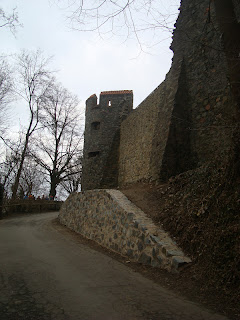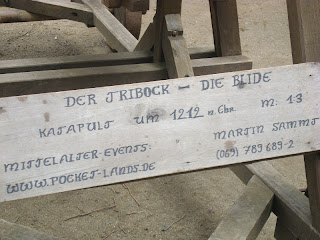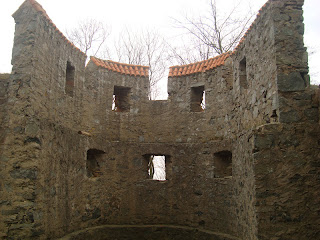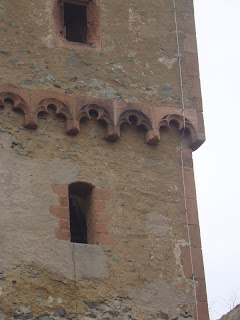I got up, tried to get the GPS set (it didnt seem to want to recognize Frankenstein's castle for some reason)...finally got it set and off I went. Now I knew kind of where it was but my GPS had me taking some off the autobahn roads. Hey what do I know, and as long as I had gas in the car and a cell phone I was ok. I am taking all these back through the villages roads, which were kind of interesting and scenic so I didnt mind. Well then I come to the road that it says for me to take, but that road is closed (silly GPS doesnt recognize closed roads in Europe)...recalculating, recalculating...ah, we have a route...and off again...on more back roads.
The good thing about taking the "scenic route" when the GPS thinks it is being funny, is that you see some things you may never have seen...such as a frog crossing sign. Yes, I said frog crossing. No, not deer crossing, not cattle crossing, Frog crossing. I guess the path is on a frog migration route.
After a while I actually made it to the road that leads up to the castle (ruins)....its a really winding road with forest all the way. Since Spring has not fully come to Germany the trees were bare, for the most part. I didnt get a picture on the way up, but this is one on the way down so you can kind of see how during the summer etc it would be rather thick.
You know, I must just have a knack for picking the right days for visits to some places. Today was all overcast...which made it easy to understand how a dreary day like today at the bases of the castle could make a lasting impression on a gothic writer. All it needed was a little lightning...but thankfully that was not on the menu for the day.
Despite there only being the ruins left of the castle, I could still get the idea of why it made such a lingering impression on writers. Ok, I was somewhat impressed with it (whether by its aw inspiring abilities or my abilities to actually get there without a trip to another country on the way). The dreary day just added to the ambiance.
There really isnt much of it left, a few towers is about all...and a little chapel. Kind of funny to think of a little chapel being by a castle that was the center of such an "unholy" story (I guess some just dont like the idea of piecing together dead people to make a live one). So rather than trying to presume to know so much about the place I will show the pictures (the ones with view are looking down on the Darmstadt area). Then I will add a little something I learned about the legend/tale of how Mary Shelly possibly ended up using the Burg Frankenstein and who it may have possibly been about...and its not a Dr. Frankenstein!
 |
| this was a cool chair that not only has the seat carved out, but foot rests too |
 |
| They have a restaurant at the castle and you can sit on the veranda and look out over to Darmstadt |
It was 1816 and on Lake Geneva during a dark and stormy summer night, four friends gathered in a stately living room by a glowing hearth. The English poet, Lord Byron, his personal physician John Polidori, Mary Shelley and Percy spent the evening entertaining one another with German ghost stories. Finally, Lord Byron made a dare, he challenged the members of the group to conjure up a story of horror. "We will each write a ghost story," he stated.
And a story Mary Shelley did write. Frankenstein was published two years later in 1818. Victor Frankenstein, obsessed with the nuances of the beauty and mysteries of life, he haphazardly pieces together the "creature." Shocked by its appearance, Victor rejects and abandons his creation, leaving his monster to fend for himself and run amok amongst the countryside.
The question is, what ties does the castle Frankenstein have with Mary Shelly’s novel? In 1814, Mary Shelley and her lover and later husband, Percy Shelley were traveling through Germany. It is believed that the Shelleys visited the Burgstrasse region during a river boat trip. In the early 1800s, the castle was visible from the Rhine and possibly provoked an excursion into the surrounding villages. Why are some literary scholars convinced? There is a connection between Victor Frankenstein and Konrad Dipple, a resident and alchemist who was born on August 10th, 1673 in the Frankenstein castle.
Johann Konrad Dipple was a rogue student at the University of Giessen. He was a scholar of radical thought and left the University after finishing his thesis entitled, De Nihilo (On Nothing), which implied that he had learned very little, or nothing from his instructors. It was then that began to travel the countryside, lecturing on subjects as divinity and astrology. Later he relocated at the castle Frankenstein, the place where he felt his family roots. Even though Dipple had no common blood with the family of Frankenstein, he considered himself a member of the Frankenstein legacy.
He became known as "Dipple the Alchemist" as was believed to have been trying to create a chemical that would prolong one’s life. Rumors circulated stating that he was collecting body parts to assist in the making of this formula. Dipple claimed that his formula was to allow him to live to the age of 135 but it is believed that he died by drinking his own potion. On the morning of April 24th, 1734, Dipple’s body was found by one of his friends. He became another legend in the history of Frankenstein.
Could Mary Shelley been told of Konrad Dipple during her presumed visit of the castle? There are connections in her story that affirm this thought. The character of Victor Frankenstein is similar to the Alchemist Dipple. Both had a passion for life. Both left their university studies to delve into a dangerous science. Both died tragically from the makings of their obsession—the obsession of harnessing life and the futile attempt to reject the manifestation of death.































































No comments:
Post a Comment